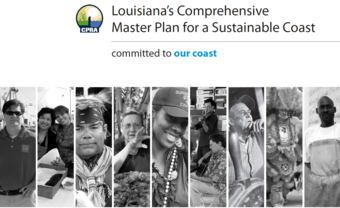Morphology Modeling in Support of the Louisiana Coastal Master Plan Active
In support of Louisiana’s 2012 Coastal Master Plan, USGS WARC scientists have developed a spatially explicit wetland morphology model and coupled it with other predictive models to help predict the effects of protection and restoration projects.

Science Issue and Relevance: Few landscape scale models have assessed the effects of coastal protection and restoration projects on wetland morphology while taking into account important uncertainties in environmental factors such as sea-level rise (SLR) and subsidence. In support of Louisiana’s 2012 Coastal Master Plan, we developed a spatially explicit wetland morphology model and coupled it with other predictive models. The model is capable of predicting effects of protection and restoration projects on wetland area, landscape configuration, surface elevation, and soil organic carbon (SOC) storage under multiple environmental uncertainty scenarios. This work is relevant to the USGS Ecosystems Mission Area as it directly relates to four of its five goals: (1) improve understanding of ecosystem structure, function, and processes; (2) advance understanding of how drivers influence ecosystem change; (3) develop tools, technologies, and capacities to inform decision making about ecosystems; and (4) apply science to enhance strategies for management, conservation, and restoration of ecosystems.
Methodology for Addressing the Issue: We are currently working on improvements to the models used for the 2012 plan in support of the development of a 2017 plan. Improvements include enhanced computation efficiency, as well as improved functions within the model.
Future Steps: We are currently working on model improvements for the 2017 Master Plan.
Location of the Study: Throughout the Louisiana coastal zone, Latitude: 29.678°, Longitude: -91.552°
In support of Louisiana’s 2012 Coastal Master Plan, USGS WARC scientists have developed a spatially explicit wetland morphology model and coupled it with other predictive models to help predict the effects of protection and restoration projects.

Science Issue and Relevance: Few landscape scale models have assessed the effects of coastal protection and restoration projects on wetland morphology while taking into account important uncertainties in environmental factors such as sea-level rise (SLR) and subsidence. In support of Louisiana’s 2012 Coastal Master Plan, we developed a spatially explicit wetland morphology model and coupled it with other predictive models. The model is capable of predicting effects of protection and restoration projects on wetland area, landscape configuration, surface elevation, and soil organic carbon (SOC) storage under multiple environmental uncertainty scenarios. This work is relevant to the USGS Ecosystems Mission Area as it directly relates to four of its five goals: (1) improve understanding of ecosystem structure, function, and processes; (2) advance understanding of how drivers influence ecosystem change; (3) develop tools, technologies, and capacities to inform decision making about ecosystems; and (4) apply science to enhance strategies for management, conservation, and restoration of ecosystems.
Methodology for Addressing the Issue: We are currently working on improvements to the models used for the 2012 plan in support of the development of a 2017 plan. Improvements include enhanced computation efficiency, as well as improved functions within the model.
Future Steps: We are currently working on model improvements for the 2017 Master Plan.
Location of the Study: Throughout the Louisiana coastal zone, Latitude: 29.678°, Longitude: -91.552°

